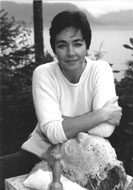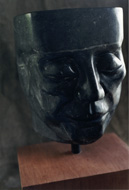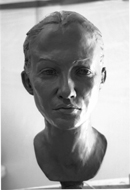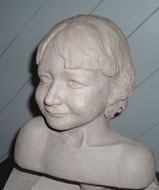For years the NWSSA has benefited from our wonderful gift from Norway. Tone’s zest for life has been invigorating our gatherings, large and small, and her willingness to explore new boundaries has been inspirational. Here, she tells us about her interesting background and exciting work.
LE: To “break the ice,” tell us a little bit about your background.
TO: I grew up in Norway, which is almost all granite and where carving has a strong and long tradition. There are public sculptures on every other street corner; children get to sit in bronze laps and ride fairytale bears. My favorite sculpture park as a child was the Gustav Vigeland Park in Oslo where I climbed around the old, naked granite-people and wondered at the conversation they seemed to be having, and why some of them were so silent. I traveled a lot, being fortunate to grow up in Europe at a time when you could just hop on a train and find yourself eating ice cream in Florence two days later. I got steeped in the European traditions, and the arts, history and cultures have never stopped inspiring me. It’s always at the back of my eyes. Even if we don’t possess the skills of the people who worked in previous centuries, we may have reached the point of clarity, simplicity, to where we allow ourselves to work towards essence and not conventional images.
LE: Given your early artistic influences, describe your pathway to becoming an artist.
TO: I was expected to become a history professor or a writer. I did study history, then philosophy and religion. At the same time, I was working with children and adolescents, orphans, refugees, physically handicapped children, child prostitutes, drug addicts, and homeless boys. The disparity between the theories I studied and the reality of the people I was working with, left me very uneasy - how do you reconcile free will with force-feeding an 11-year old anorexic?
I was also working in the European women’s movement to encourage understanding for the needs and experiences of women in other cultures. I began to see so many of the significant experiences and ways of communicating that women have, as elusive. They couldn’t fit into language, couldn’t be measured, only shared through the “tacit understanding” of a glance or a sense in the air. Subtleties and complexities were always fascinating to me, and led naturally to an interest in the arts, especially art by women. I needed some way to describe the reality of the people I knew and worked with, to make them understandable to others. But because of all the programs and the politics, I couldn’t do it with just words. I wanted to express how I felt about them, and the many changes we all go through, to try to overcome what Strindberg called “the soul’s incurable loneliness.”
I went on to write and teach, and one day I picked up oil paints and brushes. The concepts and theories had come to feel constrictive; I was just sick of words. Painting felt real in a different way and since it started from an unnamable place; there was no reasoning or predictable outcome. Then I got some Italian rasps and chisels at a sale, andfound myself alone with a white marble baby headstone. It sat on a chair in the kitchen and I banged away at it, chips flew everywhere, and I was happy! Later, when I lived next-door to a marble quarry in Sweden, a local sculptor dumped a few hundred pounds of raw clay in my barn studio, and said it was time to try modeling. I’ve had “the madness of the mud” ever since.
I was fortunate to be taken in at Ken Lundemo’s studio when I first moved to the Northwest in 1991. He needed an assistant and I needed a place to apprentice, a studio to work in, and to fire my pieces. We cast bronze with brass fittings from the Navy dump and had a lot of fun.

In 1994 I got in touch with NWSSA, and spent a day at the symposium at Camp Brotherhood. It was like coming home . I was welcomed by like-minded people who also had that sense of abandonment to something that you just love: stone. Many things changed for me through the friendships and the many symposia I’ve attended. Things like feeling that you are growing up as an artist in a family that is changing, too. Whose turn is it this year to reach that maturity and command in their art, to actualize themselves through their work? I am very grateful to the Association and the people who keep working to make each event happen.
In 1999 I started working seriously on portraiture. I’ve studied with two excellent teachers, Boris Spivak and Eugene Daub, who showed me that portraiture, as an art form, can also be a livelihood.
Because sculpture was such a personal and inner process, it took me a while to accept it as a “job.” I fought the worldly, commercial aspect of it, and had a lot of friction about the backbreaking heavy labor, how dirty it is, how fickle the rewards are, until I just accepted how much I love it. There is peace in knowing that loving it is enough. I trust the kind of sculptor I am and the merit of the kind of sculptures that I create, and trust in what I want to do, and the skills and the tools as I get better at it - the entire process of it.
These days I work almost full-time at sculpture. I do portraits for commissions, and I do my own work in stone or clay depending on the season. I take part in some shows, and I give workshops in portraiture and teach students in my studio. Teaching is really fun. Trying to help someone see – the actual model in front of them, as well as their own piece as a sculptural form – it’s always inspiring. And part of my workday is devoted to writing, since the joy of language came back with the clarity of sculpture. The rest of my time is devoted to my fantastic daughter, who is almost four now.
LE: What do you try to do in your work?
TO: To discover what’s inside, and to share what I love. That’s describing it simply, trite as it may sound. In a portrait, of course, I seek to express that essential something that is that person. In my work, it’s about a feeling, whether subtle or stark, a mood, a motion, or a complexity of feelings to contain what I feel about Bosnia, for example, or hunger, or Tibetan nuns - to follow that feeling through, to show it as clearly and cleanly as possible. I love the materials and the tools, yet it’s the process that makes it all worthwhile, the process of discovery. If I truly knew what it was about, I could write it and save myself the backache. The final product and whoever will see it aren’t important until after the sculpture has reached that stage where it feels true and can stand on its own - or not. Some times you just have to let it go free and try again.

LE: Describe a recent piece.
TO: I was working on an indolent, fleshy, young woman in Texas limestone, when she changed on me. Her hands fisted up, and her body became angular and twisted into a bitter, angry stance of powerlessness, painful inevitability. She reminded me of Kathe Kollwitz, so I named her “Eine Mutter” - A Mother. I thought she might be too emotional, too crass and ugly, too European, but there were several people who connected strongly to her and she sold right away. It confirmed to me that we can let the process dictate, allow the ‘truth’ of the piece to stand by itself, and not censure our work so.
LE: Are there sculptors who have strongly influenced you?
TO: I feel a close affinity to the Central-European sculptors from the first part of the 20th century; expressionist, even symbolist, artists like Kathe Kollwitz, Ivan Mestrovic, Ernst Barlach, and Franticek Bilek. I adore the works of Jean Arp, and admire the American sculptor Malvina Hoffman from around the same period, for her decency in her art, and for her commitment when traveling around the world to portray people of different races, some of which are extinct now.
LE: What kind of stone do you prefer to sculpt?
TO: I work with softer stone, and only carve pieces that I can carry. It could be fun to carve in a larger scale, getting into winches and hydraulics, but at this point I am happy with just the size and medium of what I do right now. I still have a lot to learn, especially when using power tools. Henry Moore talked about the desire we have to work hard and with big stones: it makes us feel virtuous. As a totally beginner carver, I tried to work granite with huge hand tools from Quebec. It was a waste of time. Mixing power tools and hand carving on the softer stones allows me the time to get into the piece and its subtleties.

LE: Describe your studio.
TO: This studio is the best I’ve ever had; it has an outdoor, covered carving space overlooking the Hood Canal and the Olympic Mountains, with eagles flying over me. It also has plenty of space indoors for modeling and the kiln and students, and all the stuff we always seem to need.
LE: What do you look forward to as a sculptor?
TO: I only want to get better, to continue to understand human anatomy, to do larger pieces eventually, and learn more about expressing motion. My pieces are already founded in expressing “the human condition.” I’d like to do that even truer and on a larger scale. I also look forward to doing more commissions. I guess what I want most of all, is more time to work.

